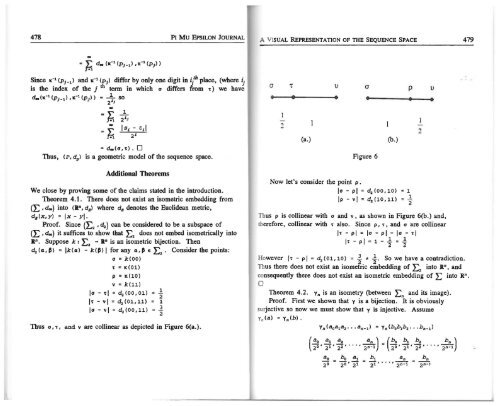Vol. 10 No 6 - Pi Mu Epsilon
Vol. 10 No 6 - Pi Mu Epsilon
Vol. 10 No 6 - Pi Mu Epsilon
- No tags were found...
You also want an ePaper? Increase the reach of your titles
YUMPU automatically turns print PDFs into web optimized ePapers that Google loves.
478 PI <strong>Mu</strong> EPSILON JOURNAL<br />
A VISUAL REPRESENTATION OF THE SEQUENCE SPACE<br />
479<br />
= Y" doo (tt- 1 (pj_ 1<br />
) , tt- 1 (pj) )<br />
/':'1<br />
Since x- 1 (pj_ 1<br />
) and x- 1 (pj) differ by only one digit in ~th place, (where ~<br />
is the index of the j th term in which a differs from 't) we have<br />
ct-cx- 1 (pj_ 1<br />
), x- 1 (pj)) = 4- so<br />
2 J<br />
..,<br />
.. ~<br />
..<br />
=~<br />
= d..,(a,'t). 0<br />
Thus, (P, d,) is a geometric model of the sequence space.<br />
a u a<br />
• • • •<br />
2<br />
(a.)<br />
Figure 6<br />
(b.)<br />
p<br />
•<br />
I<br />
- 2<br />
u<br />
•<br />
Additional Theorems<br />
We close by proving some of the claims stated in the introduction.<br />
Theorem 4.1. There does not exist an isometric embedding from<br />
(E , d..,) into (Jln, ds> where d• denotes the Euclidean metric,<br />
ds(x,y) = lx- yj.<br />
Proof. Since (1: , dz) can be considered to be a subspace of<br />
(!:,d .. ) it suffices to show that 1: does not embed isometrically into<br />
lln. Suppose k : Lz - Jln is an isometric bijection. Then<br />
dz (u, 13> = jk(u) - k I for any u, 13 E 1: . Consider the points:<br />
a = k(OO)<br />
't = 1t(01)<br />
p = x(<strong>10</strong>)<br />
v = k(ll)<br />
Ia - -rl = d 2 (00, 01)<br />
lor- vi= dz(01,ll)<br />
Ia- vi= dz(OO,ll)<br />
1<br />
- 2<br />
= 1<br />
3<br />
- 2<br />
Thus a,
















